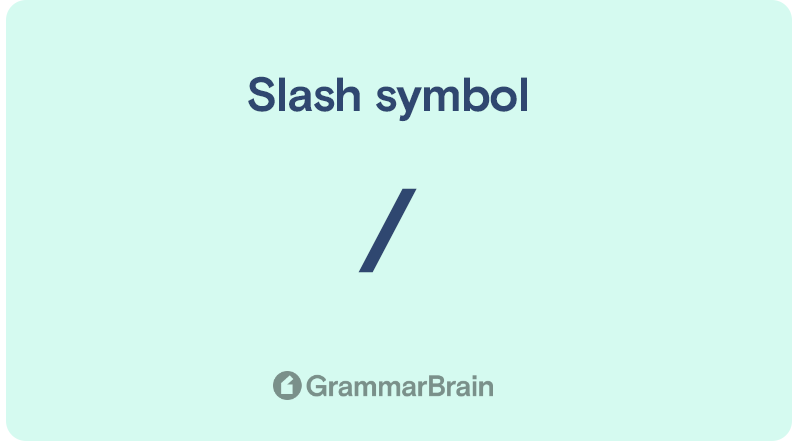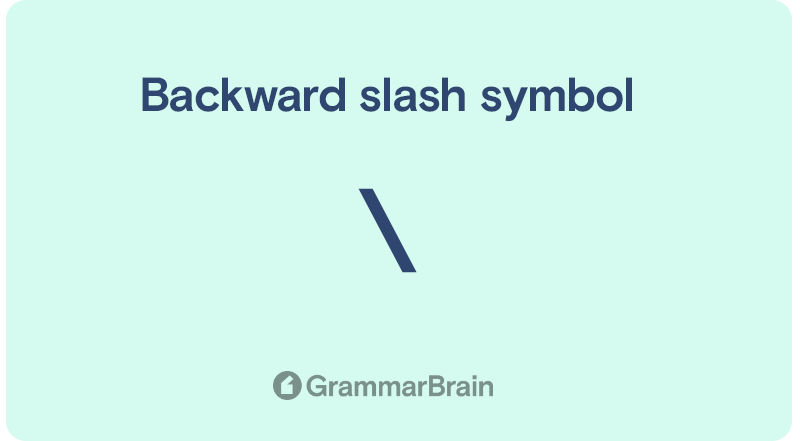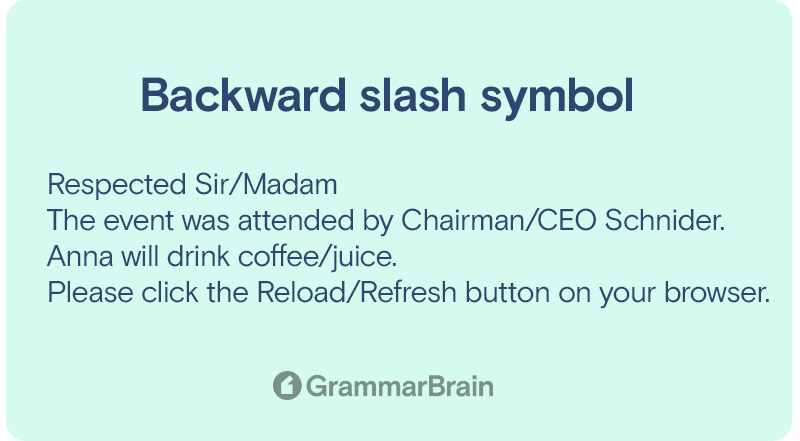What is the slash symbol? How does it function? What is the intended function of the symbol? The slash, also called a stroke, oblique, or forward slash, is a punctuation mark used in the English language. Previously used for marking commas and periods, it is now used for representing fractions, division, inclusive or exclusive, and as date separators.

Slashes: the different types
Slashes can be classified into three different types namely, forward, backward, and vertical slashes.

Backward slash symbol
Backward slashes, or backslashes, are usually used in computers and are not seen much in the context of general English writing.
- It is used in coding languages like Python as escape characters.
- It is used by Windows to denote folder locations or paths like C:Program Files\Windows Defender.
Vertical slash symbol
A vertical slash, also called an upright or straight slash, is commonly used in mathematics and coding languages. It can also mean phrases like “it is true that” or “such that.”
Forward slash symbol
In English writing, forward slashes are used for numerous purposes. Typically, a forward slash means “per,” “or,” or “and or.” Common situations where forward slashes can be used include:
It is used to separate or break lines in poetry and prose. This is usually done when numerous small lines are strung together into one long line.
Example:
- I hold the world but as the world, Gratiano,/ A stage where every man must play a part,/ And mine a sad one. ( a quote from Shakespeare’s The Merchant of Venice)
- “The female, and the two chicks,/each no bigger than my thumb,/scattered.” (a line from Mary Oliver’s poem Hummingbirds)
Slashes are frequently used to denote “or.”

Example:
- Respected Sir/Madam
- The event was attended by Chairman/CEO Schnider.
- Anna will drink coffee/juice.
- Please click the Reload/Refresh button on your browser.
When the words “and” and “or” are written beside one another, forward slashes can be used to distinguish them. This makes the text clearer and easier for the reader to comprehend compared to repeating ‘and.”
Example:
- The mother instructed her kids to buy a gallon of milk and/or a bag of potatoes from the grocery store.
- Anna couldn’t wait to go scuba diving and/or snorkeling while visiting Thailand next summer.
- Remember to take rain boots and/or waterproof shoes on your vacation to Mawsynram.
It can be used for separating month, day, and year when writing dates.
Example:
- Anna’s grandfather passed away on 11/25/2007. (November 25, 2007; American English format)
- The airplane was invented on 17/12/1903 by the Wright brothers. (17th December 1903; British English format)
It is used in some abbreviations.
Example:
- This is John’s a/c number. (account)
- n/a (not available, not applicable)
- Caleb White c/o Anna White (care of)
- w/o (without)
It is used for writing fractions like 1/4 (one-fourth), 2/6 (two-sixth), or 1/3 (one-third).
It is used to denote “per” when writing measurements of quantities like speed and price.
Examples:
- The little boy is running at 5 m/s. (meters per second)
- The rice costs $3/kg. ($3 per kg)
It is used to show the conflict or connection between phrases or words in a sentence.
Example:
- The manager sometimes works in her home office/ bonus room.
- The pro-choice/pro-life debate has become the focal point of all discussions this election season.
It is used to separate the name of a book or movie from the name of its author, director, or distribution company based on Anglo-American Cataloguing Rules.
Example:
- To Kill a Mockingbird/ by Harper Lee
- Star Wars: Episode III – Revenge of the Sith/ 20th Century Fox
In phonetics, forward slashes can be employed to denote changes in letter pronunciation. The slashes serve as phoneme indicators in this case. When letters or groups of letters are enclosed by two slashes, it means that the pronunciation is based on sounds (phonemic pronunciation).
Example:
- Consider the phoneme /j/. It refers to the sounds “j,” “g,” “ge,” and “dge” in “jet,” “cage,” “barge,” and “judge” respectively.
- The phoneme /ch/ refers to the sounds “ch” and “tch” in “chip” and “match,” respectively.
Use of the forward slash to denote “or” should be minimized by authors since it can imply laziness. Similarly, the term “and/or” is frequently regarded as quite impolite.
More punctuation marks
| Symbol | Name | Example |
| . | Period | I got this at the fair. |
| ? | Question mark | How many trucks does he have? |
| ! | Exclamation point | Wow! You’re a great rider. |
| , | Comma | I like the movie, but the color grading is odd to me. |
| : | Colon | Here are some fun ideas for the party: trivia questions, shuffle board, and more. |
| ; | Semicolon | I’ll visit you once I’m done with work; that’s a promise. |
| – | Hyphen | I have double-life situations. |
| – | En dash | How long is a China-Russia fight? |
| — | Em dash | The dog—and I’m afraid of four-legged animals—was so adorable. |
| ( ) | Parentheses | His favorite team (Chicago Bulls) has a chance to win the title. |
| [ ] | Square brackets | The AP writer said “[head] of baseball operations was disappointed.” |
| { } | Curly brackets | The colors {orange, green, lilac, blue} are for the garage. |
| < > | Angle brackets | |
| “ ” | Quotation marks | Bryan called it a “great situation.” |
| ‘ | Apostrophe | Some of Susan’s clothes are missing. |
| / | Slash or Virgule | I’m ordering food/dessert/more. |
| … | Ellipses | According to the school the “president… was disappointed.” |
| * | Asterisk | *Data from The Economist |
| & | Ampersand | Tiffany & Co. |
| • | Bullet point | • Simple • Great • Awesome |
| # | Pound symbol | #1 selling |
| ~ | Tilde | Bryan owns ~10 pairs of shoes. |
| \ | Backslash | |
| @ | At symbol | [email protected] |
| ^ | Caret symbol | 3^3 = 27 |
| | | Pipe symbol |
FAQs
Should space be used before or after writing the slash?
Many authors face this issue and often wonder when to use the space, before or after the slash. This mainly depends on the content of the text. If the sentence is showing alternatives between two words, it is advisable to not use any space before or after the slash.
The use of spaces before and after slashes to denote alternatives between multi-word expressions, phrases, or compounds makes the text simpler to read and understand.
When separating lines of plays, poems, or songs, using the space after the slash is also acceptable. Also, a line break must follow the slash.
Example:
- After removing the dish from the oven, mix cocoa butter and/or regular butter into it.
- World War II / Second World War
- Humpty Dumpty sat on a wall, / Humpty Dumpty had a great fall (from the nursery rhyme Humpty Dumpty)
Are forward slashes used in formal or informal settings?
Forward slashes are not generally preferred in business documents or formal academic papers. But they can be used in numerous informal settings as well as for writing dates. Authors typically use forward slashes to spice up an otherwise dull piece of writing.
But it should be noted that using too many slashes feels like an eyesore or an indication of lazy writing. Authors should use slashes sparingly and carefully.
Sources:
- Merriam Webster – slash noun (1) – Definition
- Wikipedia – Slash (punctuation)
- Thesaurus.com – What Are Forward Slashes ( / ) And How Do You Use Them?
- Symbols.com – Slash
Inside this article
Fact checked:
Content is rigorously reviewed by a team of qualified and experienced fact checkers. Fact checkers review articles for factual accuracy, relevance, and timeliness. Learn more.
Core lessons
Glossary
- Abstract Noun
- Accusative Case
- Anecdote
- Antonym
- Active Sentence
- Adverb
- Adjective
- Allegory
- Alliteration
- Adjective Clause
- Adjective Phrase
- Ampersand
- Anastrophe
- Adverbial Clause
- Appositive Phrase
- Clause
- Compound Adjective
- Complex Sentence
- Compound Words
- Compound Predicate
- Common Noun
- Comparative Adjective
- Comparative and Superlative
- Compound Noun
- Compound Subject
- Compound Sentence
- Copular Verb
- Collective Noun
- Colloquialism
- Conciseness
- Consonance
- Conditional
- Concrete Noun
- Conjunction
- Conjugation
- Conditional Sentence
- Comma Splice
- Correlative Conjunction
- Coordinating Conjunction
- Coordinate Adjective
- Cumulative Adjective
- Dative Case
- Determiner
- Declarative Sentence
- Declarative Statement
- Direct Object Pronoun
- Direct Object
- Diction
- Diphthong
- Dangling Modifier
- Demonstrative Pronoun
- Demonstrative Adjective
- Direct Characterization
- Definite Article
- Doublespeak
- False Dilemma Fallacy
- Future Perfect Progressive
- Future Simple
- Future Perfect Continuous
- Future Perfect
- First Conditional
- Irregular Adjective
- Irregular Verb
- Imperative Sentence
- Indefinite Article
- Intransitive Verb
- Introductory Phrase
- Indefinite Pronoun
- Indirect Characterization
- Interrogative Sentence
- Intensive Pronoun
- Inanimate Object
- Indefinite Tense
- Infinitive Phrase
- Interjection
- Intensifier
- Infinitive
- Indicative Mood
- Participle
- Parallelism
- Prepositional Phrase
- Past Simple Tense
- Past Continuous Tense
- Past Perfect Tense
- Past Progressive Tense
- Present Simple Tense
- Present Perfect Tense
- Personal Pronoun
- Personification
- Persuasive Writing
- Parallel Structure
- Phrasal Verb
- Predicate Adjective
- Predicate Nominative
- Phonetic Language
- Plural Noun
- Punctuation
- Punctuation Marks
- Preposition
- Preposition of Place
- Parts of Speech
- Possessive Adjective
- Possessive Determiner
- Possessive Case
- Possessive Noun
- Proper Adjective
- Proper Noun
- Present Participle
- Prefix
- Predicate



